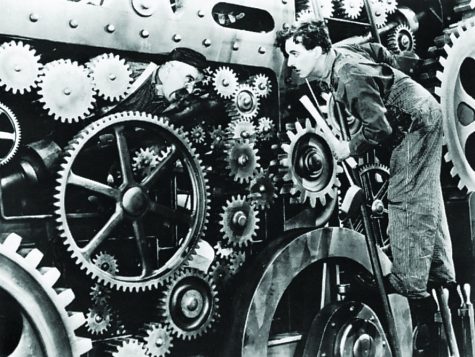If You Just Smile: Joker as a Parallel of the Tramp
NOTE: Major spoilers for both Joker (2019) and Modern Times (1936). Read with discretion.
Charlie Chaplin is a name inseparable from the film industry. His character, the “Little Tramp” landed him in the hearts of our nation, conjoined him to the silent film era, and left millions to discover his works now almost a century into the future. I am one of them.
Arthur Fleck (Joaquin Phoenix) is far less endearing.
Arthur has schizotypal personality disorder. He just wants to make people happy; unfortunately, the world he lives in rejects him because of his mental illness. In his own words, he writes, “the worst part about having a mental illness is that people expect you to behave as if you don’t.” So he turns to giving people “what they deserve.”
When comparing the goofy, upbeat Tramp and Phoenix’s troubled Joker, not many common images come into mind. However, there are plenty of connections between Charlie Chaplin and Joker.
In Joker, there is a special showing of Charlie Chaplin’s Modern Times, available only to Gotham’s richest and most powerful. And as shown in the teaser, thousands of impoverished Gothamites take to the streets in front of the building, protesting against the rich while they live on the streets, sleeping next to literal garbage. This series of events isn’t a coincidence.
Modern Times follows the Tramp as he attempts to work his way up the system and eventually live with his new love, a Gamin (street urchin). Together, they find a new house and work and attempt to live out the famed “American Dream.”
The first half of the movie follows the Gamin as she fends for herself and her sisters on the streets, stealing bananas and consoling their single father. The Tramp, in the meantime, is working away in a factory, where the monotony and boredom eventually drives him insane. He is promptly fired and imprisoned. The Gamin’s father is killed during a protest, and she flees to prevent her orphanage, where by chance she runs into the Tramp.
Already the similarities are striking. Arthur is already “insane” to begin with, and works in a job that treats him horribly; his sign is stolen and destroyed and himself beaten up minutes after the opening title card rolls, then he has to pay for the ruined sign. While returning from work, he meets Sophie, a single mother similarly oppressed under the system.
Joker and Modern Times have similar messages: they both critique how society oppresses the lower class. This makes it all the more ironic that Modern Times is being viewed in an exclusive theater in Joker, in a place reserved for the rich, and makes the subsequent protests all the more meaningful. Even the few scenes we are shown of Modern Times in Joker affirm this. When Arthur sneaks into the theater, we see glimpses of Chaplin’s famous roller skating stunt, dancing without a care. This freedom is prevalent in Joker as well: Arthur’s dance in the beginning of the film being slow and constricted, to unrestrained and powerful by the end.
The real kicker comes later in both films. In Joker, Arthur unwittingly starts a movement when he shoots and kills three Wall Street brokers who were assaulting him on a subway. Chaplin’s character starts a similar protest when he waves around a flag to find its owner. This is where their paths begin to diverge.
The Tramp and the Gamin are forced to flee their new jobs after the police, who want to take the Gamin in for escaping imprisonment, find her. The two main characters are last seen walking away into the sunset, with the Tramp reaffirming his lover and telling her to smile, and that things are starting to look up.
For Arthur, a similar uplifting moment happens midway through the film. For the first time, Arthur performs a segment for a stand-up comedy show, and believes that it went well. He and Sophie go out into the streets for donuts and a stroll. They both laugh and smile. For Arthur, things are looking up. Over this sequence plays “Smile,” the song created, composed, and used by Chaplin in the final scene to Modern Times. Once again, no coincidence.
This is where things take a turn. While Modern Times ends there, Joker is far from over, going to a far darker place than its Charlie Chaplin-starring counterpart.
Ultimately, Joker, in many ways a spiritual double to Modern Times without its shell of satire and slapstick, plays out like an homage to Charlie Chaplin. Chaplin noted in Modern Times that American industrialization was causing the lower class to suffer. The 1929 Great Depression served as his proof. Joker states that the consolidation of wealth is causing the poor to suffer further. Its proof is perhaps the 1973 oil crisis, or closer to home, the 2008 Great Recession. Modern Times ended with a scene espousing the truth of the American Dream. Joker takes that ideal, holds it up to our faces, then dashes it against the rocks. Perhaps it is fitting that both have drawn such attention and such controversy.
Joker debuted on October 4th. Rated R for strong bloody violence, disturbing behavior, language and brief sexual images (CARA).

You can take the woman out of the bird, but you can't take the bird out of the woman: meet Yoon Lee.

